R-36 (missile)
The R-36 (Russian: Р-36) is a family of intercontinental ballistic missiles (ICBMs) and space launch vehicles (Tsyklon) designed by the Soviet Union during the Cold War. The original R-36 was deployed under the GRAU index 8K67 and was given the NATO reporting name SS-9 Scarp. It was able to carry three warheads and was the first Soviet MRV(multiple reentry vehicle) missile.[1] The later version, the R-36M was produced under the GRAU designations 15A14 and 15A18 and was given the NATO reporting name SS-18 Satan. This missile was viewed by certain United States analysts as giving the Soviet Union first strike advantage over the U.S., particularly because of its rapid silo-reload ability, very heavy throw weight and extremely large number of re-entry vehicles. Some versions of the R-36M were deployed with 10 warheads and up to 40 penetration aids and the missile's high throw-weight made it theoretically capable of carrying more warheads or penetration aids. Contemporary U.S. missiles, such as the Minuteman III, carried up to three warheads at most.
| R-36 | |
|---|---|
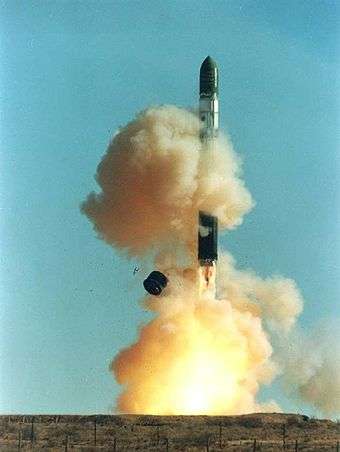 | |
| Type | Intercontinental ballistic missile |
| Place of origin | Soviet Union (Ukraine) |
| Service history | |
| In service | 1974–present (only R-36M2 Voevoda variant) |
| Used by | Russian Strategic Missile Troops Ukraine (former operator) |
| Production history | |
| Manufacturer | Factory: Yuzhny Machine-Building Plant Developer: Yuzhnoye Design Office Ukraine |
| Specifications | |
| Mass | 209,600 kg (462,100 lb) |
| Length | 32.2 m (106 ft) |
| Diameter | 3.05 m (10.0 ft) |
| Warhead | Depending on variant (see variants); the current one (R-36M2 Mod. 5), 10 × 550–750 kiloton MIRV warheads with a large amount of decoys and other penetration aids. Originally (Mod. 1), 1 × 18–25 megaton warhead. |
| Engine | RD-250 Two-stage liquid propellant |
Operational range | 10,200–16,000 km |
Guidance system | Inertial, autonomous |
| Accuracy | 220–700 m CEP |
Launch platform | Silo |
The R-36 became the base for the Tsyklon launch vehicles family. As of early 2018, Cyclone-4M, the last modification of it, is developed and planned for launch in 2020.
Russia intends to replace the R-36M with a new heavy ICBM, the RS-28 Sarmat.
Some R-36 missiles have been converted into Dnepr medium-lift launch vehicles, capable of putting up to 4,500kg into orbit.
History
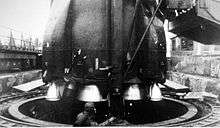
Development of the R-36 was begun by OKB-586 (Yuzhnoye) in Dnepropetrovsk, Ukraine (at the time part of the Soviet Union) in 1962, and built upon the work of the R-16 program. The Chief Designer was Mikhail Yangel. Initial development was of light, heavy, and orbital versions, with flight testing from 1962 through 1966, at which time initial operational capability was achieved. News of the development of the orbital version caused alarm in the West with the possibility that the Soviets would be able to launch a large number of nuclear weapons into orbit where there was no capability to intercept them. The prospect of orbital nuclear weapons led both sides to agree to a treaty banning the basing of weapons of mass destruction in space.
In 1970, development of a fourth version, capable of delivering multiple warheads, was begun, which was test flown the next year.
Further improvement of the R-36 led to the design of the R-36M, which provided a theoretical first-strike capability—the ability to destroy the United States' LGM-30 Minuteman ICBM silos and launch control centers before they could retaliate. However, neither the Soviet Union nor the Russian Federation have ever publicly delineated the missile's particular role in their arsenal. The initial design of the R-36M called for a single massive 12 Mt warhead to be delivered over a range of 10,600 km. The missile was first tested in 1973 but this test ended in failure. After several delays the R-36M was deployed in December 1975. This "Mod-1" design was delivered with a single 18–20 Mt warhead and a range of just over 11,000 km. This new version was given a new identity by NATO: SS-18 Satan.
The R-36M has gone through six separate modifications, with the first modification (Mod-1) being phased out by 1984. The final modification (Mod-6) designated R-36M-2 "Voevoda" was deployed in August 1988. This missile could deliver the same 18–20 Mt warhead 16,000 km. Modifications prior to Mod-6 mainly introduced MIRV (Multiple independent reentry vehicles) warheads. These missiles (Mods-2, 4, and 5) surpassed their western counterpart, the US LGM-118 Peacekeeper in terms of megatons delivered, range, and survivability, but were inferior in terms of accuracy (CEP).
The control system for this rocket was designed at NPO "Electropribor"[2] (Kharkiv, Ukraine).
Deployment
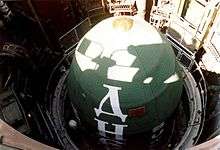
At full deployment, before the fall of the Soviet Union in 1991, 308 R-36M launch silos were operational. After the breakup of the USSR, 204 of these were located on the territory of the Russian Federation and 104 on the territory of newly independent Kazakhstan. In the next few years Russia reduced the number of R-36M launch silos to 154 to conform with the START I treaty. Part of the missiles in Kazakhstan (54 of them) were under the 57th Rocket Division at Zhangiz-Tobe (Solnechnyy), Semipalatinsk Oblast.[3] The other R-36 establishment in Kazakhstan was the 38th Rocket Division at Derzhavinsk, Turgay Oblast.[4] The dismantling of 104 launchers located in Kazakhstan was completed in September 1996. The START II treaty was to eliminate all R-36M missiles but it did not enter into force and the missiles remained on duty. Russia has steadily decreased the number of operational R-36Ms and as of March 2013, only 55 (all of the 10 MIRV Mod 5 version) remain.[5] About 40 missiles will have their service lives extended so that they remain in service until about 2020. With the retirement of the 20 megaton SS-18 Mod 6 warheads, the highest yield weapon in service with any nation is the estimated 5 Mt Chinese Dong Feng 5 (DF-5) ICBM (CSS-4) warhead and the Russian UR-100N 5 Mt rocket.
US Air Force National Air and Space Intelligence Center estimates that as of June 2017 about 50 Mod 5 launchers were operationally deployed.[6]
Elimination
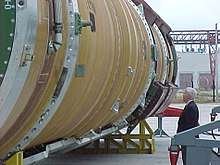
In the last decade Russian armed forces have been steadily reducing the number of R-36M missiles in service, withdrawing those that age past their designed operational lifetime. About 40 missiles of the most modern variant R-36M2 (or RS-20V) will remain in service until 2019.[7] As of January 2016, the Strategic Missile Troops had 46 R-36M2s in active service.[8]
In March 2006 Russia made an agreement with Ukraine that will regulate cooperation between the two countries on maintaining the R-36M2 missiles. It was reported that the cooperation with Ukraine will allow Russia to extend the service life of the R-36M2 missiles by at least ten to 28 years.[9]
The commander of the Strategic Missile Troops Lt. Gen. Andrei Shvaichenko announced on December 16, 2009, that Russia planned to "develop a new liquid-propellant ICBM (RS-28 Sarmat) to replace the Voyevoda (SS-18 Satan), capable of carrying 10 warheads, by 2016."[10]
According to Interfax report, two R-36M2 missiles are planned to be dismantled by November 30, 2020. The process is to be carried out in accordance with the New START procedures.[11]
Design
Multiple warheads
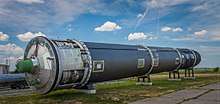
Missiles of the R-36M/SS-18 family have never been deployed with more than ten warheads, but given their large throw-weight (8.8 tonnes as specified in START), they have the capacity to carry considerably more detonation power. Among the projects that the Soviet Union considered in the mid-1970s was that of a 15A17 missile—a follow-on to the R-36MUTTH (15A18).[12] The missile would have had an even greater throw-weight—9.5 tonnes—and would be able to carry a very large number of warheads. Five different versions of the missile were considered. Three of these versions would carry regular warheads — 38 × 250 kt yield, 24 × 500 kt yield, or 15–17 × 1 Mt yield. Two modifications were supposed to carry guided warheads ("upravlyaemaya golovnaya chast") — 28 × 250 kt or 19 × 500 kt.[12] However, none of these upgraded models were ever developed. The SALT II Treaty, signed in 1979, prohibited increasing the number of warheads ICBMs could carry. Equally, from a strategic point of view, concentrating so many warheads on silo-based missiles was not seen as desirable, since it would have made a large proportion of the USSR's warheads vulnerable to a counterforce strike.
The operational deployment of the R-36M/SS-18 consisted of the R-36MUTTH, which carried ten 500 kt warheads, and its follow-on, the R-36M2 (15A18M), which carried ten 800 kt warheads (single-warhead versions with either 8.3 Mt or 20 Mt warhead also existed at some point). To partially circumvent the treaty, the missile was equipped with 40 decoys to utilize the capacity left unused due to the 10-warhead limitation.[13] These decoys would appear as warheads to any defensive system, making each missile as hard to intercept as 50 single warheads, rendering potential anti-ballistic defense ineffective.
Variants
R-36 (SS-9)
R-36
The R-36 (SS-9) is a two-stage rocket powered by a liquid bipropellant, with UDMH as fuel and nitrogen tetroxide as an oxidizer. It carries one of two types of re-entry vehicles (RVs) developed especially for this missile:
R-36ORB
The development of the R-36 missile complex for use with the 8К69 (termed Fractional Orbital Bombardment System in the West, NATO reporting name SS-9 Mod 3) began on April 16, 1962. Such a missile provided some advantages over a conventional ICBM. The range is limited only by the parameters of the orbit that the re-entry vehicle has been placed into, and the re-entry vehicle may come from either direction, compelling the enemy to build considerably more expensive anti-missile systems. Due to the possibility of placing the warhead in orbit and keeping it there for some time, it is possible to reduce the time required to strike to just a few minutes. It is also much more difficult to predict where the warhead will land, since while the re-entry vehicle is on orbit, it is a very small object with few distinguishing marks and is hard to detect. Moreover, since the warhead can be commanded to land anywhere along the orbit's ground track, even detecting the warhead while it is in orbit does not allow accurate prediction of its intended target.
Early R-36s used radio ground guidance on the reasoning that it would be more accurate than inertial guidance, however, the engineers eventually scrapped this when they decided that inertial guidance was good enough.
The structure and design of the fractional orbit bombardment system were similar to a conventional R-36 ICBM system. The main difference from a conventional ICBM was in the design of the re-entry vehicle, which is fitted with a single 2.4 Mt warhead, a de-orbit engine, and control block. The control system independently uses inertial guidance and a radar altimeter which measure orbit parameters twice, once at the beginning of the orbital trajectory and again just before the firing of engines for de-orbiting. The silo launcher and command point were hardened against a nuclear blast.
The Soviet Union constructed two surface pads at Baikonur for R-36 tests at LC-67/1 and LC-67/2, and six silos (two at LC-80 and one each at LC-140, LC-141, and LC-142).
The first launch of an R-36 took place on September 28, 1963, and ended ignominiously when the missile lost thrust one second after liftoff and fell back onto the pad, exploding. This debacle led to program director V.P. Petrov being fired and replaced by V.N. Soloviev. LC-67/1 was repaired and the next test took place successfully on December 3. Subsequent testing went better, however, LC-80/1 had to be rebuilt following another launch accident on January 13, 1965. Two months later, an R-36 caught fire during propellant loading on LC-67/1 and exploded, putting the pad out of commission for nine months. During test launch #17 (October 10, 1964), the warhead was retrieved with a parachute. Flight tests of the rocket were completed by May 20, 1968, and on November 19 of the same year it entered service. The first (and only) regiment with 18 launchers was deployed on August 25, 1969. A total of 139 8K67s flew between 1963 and 1975 with 16 failures.
The USSR retired the R-36ORBs (8К69) from service in January 1983 as a part of SALT II treaty.
The Tsyklon series of civilian space launchers Ukraine is based on the R-36orb (8К69) design. CYCLONE-2 CYCLONE-2 (archive.org)
R-36P
The R-36P missile (SS-9 Mod 4) carried three re-entry vehicles. As with the original R-36, it was hot launched from the silo.
R-36M (SS-18)
The R-36M (SS-18), known as Satan by NATO, is similar to the R-36 in design, but has the capacity to mount a MIRV payload of 10 warheads, each with a 550–750 kt yield, or a single warhead of up to 20 Mt. Throw-weight of the missile is 8,800 kg. This makes the Soviet R-36 the world's heaviest ICBM; for comparison, the heaviest US ICBM (the retired LGM-118 Peacekeeper, that carried 10 warheads of 300 kt each) had less than a half of this, at 4,000 kg. The R-36M has two stages. The first is a 460,000 kgf (4.5 MN) thrust motor with four combustion chambers and nozzles. The second stage is a single-chamber 77,000 kgf (755 kN) thrust motor.
The R-36M was placed into a 39m deep silo in a tubular storage/launch container. Upon launch, the missile uses a soft launch (also called a cold launch) system where the missile was launched out of the silo by a gas generator. [14] The missile's engines would then ignite tens of metres above the ground. A soft launch system reduced the exposure to shock-waves and over-pressure found in igniting a missile inside a confined space like a silo.
R-36M (SS-18 Mod 1)
The SS-18 Mod 1 carried a single large reentry vehicle, with a warhead yield of 18-25 Mt, a distance of about 6,000 nautical miles (11,000 km). In January 1971, cold-launch tests began during which the mortar launch was perfected. The actual flight tests for the single-RV Mod 1 began on 21 February 1973, though some sources suggest that testing began in October 1972. The testing phase of the R-36M with various different types of warheads was finished in October 1975 and on 30 December 1975 deployment began (though some Western sources suggest that an initial operational capability was reached in early 1975). A total of 56 were deployed by 1977, though all were replaced by Mod 3 or Mod 4 missiles by 1984. These high-yield weapons were assessed in the West as possibly developed to attack American Minuteman ICBM launch control centers.
R-36M (SS-18 Mod 2)
The SS-18 Mod 2 included a post-boost vehicle and up to eight reentry vehicles, each with a warhead yield estimated at between 0.5 and 1.5 Mt, with a range capability of about 5,500 nmi. The MIRVs were placed in pairs, and a post boost vehicle with a command structure and a propulsion system were contained in the nose cone of the R-36M. The flight tests of the MIRVed Mod 2 began in September 1973 (though some Western sources suggest that the initial flight test of the Mod 2 MIRV version occurred in August 1973), with IOC in 1975. Approximately 132 were deployed by 1978, but the post-boost vehicle design was seriously flawed, and the Mod 2 missiles were all replaced by the Mod 4 variant by 1983.
R-36M (SS-18 Mod 3)
The SS-18 Mod 3 carried a single large reentry vehicle that was an improved version of the SS-18 Mod 1. On 16 August 1976, a few months after the R-36M entered service, the development of an improved modification of the R-36M (15A14) was approved. This missile subsequently received the designation R-36MUTTKh (15A18) and was developed by KB Yuzhnoye (OKB-586) through December 1976. The R-36MUTTKh was capable of carrying two different nose cones. On 29 November 1979, deployment of the improved R-36M with a single reentry vehicle carrying an 18–25 Mt warhead (SS-18 Mod 3) began. This variant is no longer in service.[15]
R-36MUTTKh (SS-18 Mod 4)
The SS-18 Mod 4 was probably designed to attack and destroy ICBMs and other hardened targets in the US. Its increasing accuracy made it possible to reduce the yield of the warheads and allowed an increase in the number of warheads from 8 to 10. According to some Western estimates, evidence suggested that the Mod 4 may be capable of carrying as many as 14 RVs (this may reflect observation of the deployment of countermeasures intended to overcome a ballistic missile defense, or to confuse American attack characterization systems). The flight-design tests of the R-36MUTTKh began on 31 October 1977 and in November 1979 the flight tests of the MIRVed missile were completed. The first three regiments were put on alert on 18 September 1979. During 1980 a total of 120 SS-18 Mod 4 missiles were deployed, replacing the last remaining R-36 (SS-9) missiles. In 1982–1983 the remaining R-36M missiles were also replaced with the new R-36MUTTKh and the total number of deployed missiles reached the maximum 308 ceiling established in the SALT-1 treaty. The SS-18 Mod 4 force had the estimated capability to destroy 65 to 80 percent of US ICBM silos using two nuclear warheads against each. Even after this type of attack, it was estimated that more than 1000 SS-18 warheads would be available for further strikes against targets in the US. After 2009, the SS-18 Mod 4s were all eliminated in favor of the newer SS-18 Mod 5.
R-36M2 Voevoda (SS-18 Mod 5)
The newer, more accurate SS-18 Mod 5 version placed in converted silos allowed the SS-18 to remain the bulwark of the SRF’s hard-target-kill capability. The Mod 5 carries 10 MIRVs, each having a higher yield than the Mod 4 warheads. The Mod 5 warheads have nearly twice the yield of the Mod 4 (approximately 750 kt to 1 Mt) according to Western estimates, though Russian sources suggest a yield of 550–750 kt each. The increase in the Mod 5's warhead yield, along with improved accuracy, would, under the START treaty, help allow the Russians to maintain their hard-target-kill wartime requirements even with the 50 percent cut in heavy ICBMs the START agreement required. The technical proposals to build a modernized heavy ICBM were made in June 1979. The missile subsequently received the designation R-36M2 Voevoda and the industrial index number 15A18M. The design of the R-36M2 was completed in June 1982. The R-36M2 had a series of new engineering features. The engine of the second stage is completely built into the fuel tank (earlier this was only used on SLBMs) and the design of the transport-launching canister was altered. Unlike the R-36M, the 10 warheads on the post-boost vehicle are located on a special frame in two circles. The flight tests of the R-36M2 equipped with 10 MIRVs began in March 1986 and were completed in March 1988. The first regiment with these missiles was put on alert on 30 July 1988 and was deployed on 11 August 1988. SS-18 Mod 5 is the only operational variant.
One of the missile's most important features is its storage/basing in a container, inserted in the silo. The container doubles as a mortar barrel - it has a "piston" at its bottom, beneath the missile. The drum-like "piston" is filled with a slow-burning, gas pressure-generating charge that pushes, mortar-like, the missile from the container. Only when several meters above the silo with the now empty container the "piston" is pushed sideways by a small rocket motor to avoid being accelerated towards the silo by the ignition of the missile's main engine. Thus the silo is a) spared the burning-out by the main engine flames, and so b) the empty container could be quickly removed and a new container with missile could be inserted by a ready transporter/erector into the intact silo, allowing for a second salvo before the adversary's warheads arrive. This feature was a deep concern for the US side during the SALT/START negotiations, as it gave Soviet Union the possibility to strike US targets again after the first missile exchange was concluded.
R-36M2 Voevoda (SS-18 Mod 6)
The flight tests of the R-36M2 missile carrying a single warhead (SS-18 Mod 6) with a yield of 20 Mt were completed in September 1989 and deployment began in August 1991. Ten Mod 6 missiles were deployed. One intended use of these large warheads was high altitude detonation to incapacitate electronics and communications through a very large electromagnetic pulse, however, the most likely use would be against missile launch control centers as the stated purpose of the Mod 3 warheads were designed. The SS-18 Mod 6 missiles were all decommissioned by late 2009.
Derivatives
Several remaining R-36M missiles have been modified for commercial launch from silos and now carry lightweight satellites to low Earth orbit (LEO), including many foreign payloads.
The Tsyklon-2 was able to carry 2,820 kg into LEO and the Tsyklon-3 could carry 4,100 kg to LEO. They were retired in 2006 and 2009 respectively.
The Dnepr launch system can carry 4,500 kg to LEO. 150 R-36M missiles are available for Dnepr conversion until 2020.
A proposal has been advanced to modify Voyevoda R-36M Satan heavy ICBMs to destroy incoming asteroids of up to 100 m, similar to the Chelyabinsk asteroid.[16]
All R-36 variants were designed to be launched from silos in dispersed and hardened locations.
| System: | R-36M | R-36M | R-36M | R-36MUTTKh | R-36M2 | R-36M2 |
|---|---|---|---|---|---|---|
| Treaty-designation: | RS-20A | RS-20A1 | RS-20A2 | RS-20B | RS-20B | RS-20V |
| GRAU-designation: | 15A14 | 15A14 | 15A14 | 15A18 | 15A18 | 15A18M |
| NATO-designation: | SS-18 Satan Mod 1 | SS-18 Satan Mod 2 | SS-18 Satan Mod 3 | SS-18 Satan Mod 4 | SS-18 Satan Mod 5 | SS-18 Satan Mod 6 |
| Deployment: | 1974–1983 | 1976–1980 | 1976–1986 | 1979–2005 | 1988–Present | 1991–2009 |
| Maximum deployed number: | 148 | 10 | 30 | 278 | 104 | 58 |
| Length: | 32.6 m | 32.6 m | 32.6 m | 36.3 m | 36.3 m | 34.3 m |
| Diameter: | 3.00 m | 3.00 m | 3.00 m | 3.00 m | 3.00 m | 3.00 m |
| Launch weight: | 209,600 kg | 209,600 kg | 210,000 kg | 211,100 kg | 211,100 kg | 211,100 kg |
| Number of warheads: | 1 | 8 | 1 | 10 | 10 | 1 |
| Warhead yield: | 20 Mt | 0.5-1.3 Mt | 25 Mt | 0.55 Mt | 1 Mt | 20 Mt |
| Range: | 11,200 km | 10,200 km | 16,000 km | 16,000 km | 11,000 km | 16,000 km |
| CEP: | 1000 m | 1000 m | 1000 m | 920 m | 500 m | 500 m |
Operators
The Strategic Missile Troops are the only operator of the R-36. As of January 2020[20], 46 silo-based missiles are deployed with:
- 13th Red Banner Rocket Division at Yasny, Orenburg Oblast
- 62nd Rocket Division at Uzhur, Krasnoyarsk Krai
Former operators
See also
- Strategic Missile Troops
- RS-24 Yars
- RS-26 Rubezh
- RS-28 Sarmat
- UR-100N
- RT-2PM Topol
- RT-2PM2 Topol-M
- LGM-30 Minuteman
- LGM-25C Titan II
- DF-5
- DF-41
- Hwasong-14 (uses same engine)
References
- Helms, Richard; Hood, William (2004). A Look Over My Shoulder: A Life in the Central Intelligence Agency. p. 385. ISBN 0812971086.
- "Krivonosov, Khartron: Computers for rocket guidance systems". Retrieved 14 November 2014.
- "57th Missile Division". Ww2.dk. Retrieved 26 September 2011.
- "38th Missile Division". Ww2.dk. Retrieved 26 September 2011.
- "Russian nuclear forces, 2013". Retrieved 14 November 2014.
- http://www.nasic.af.mil/LinkClick.aspx?fileticket=F2VLcKSmCTE%3d&portalid=19
- "Russia to test launch 14 ICBMs in 2009 - missile forces chief". RIA Novosti. 10 April 2009. Retrieved 26 September 2011.
- http://russianforces.org/missiles/
- "Russia and Ukraine will maintain R-36M2 missiles - Blog - Russian strategic nuclear forces". Russian strategic nuclear forces. 24 January 2008. Retrieved 20 November 2015.
- "Russia says destroyed 9 ICBMs in 2009 under START 1 arms pact". Sputnik. 16 December 2009. Retrieved 20 November 2015.
- "Россия утилизирует в 2020 году две межконтинентальные ракеты "Воевода"". Interfax (in Russian). 3 January 2020. Retrieved 3 January 2020.
- Multiple (as in "up to 38") warheads - Blog - Russian strategic nuclear forces
- "Moscow extends life of 144 cold war ballistic missiles". The Guardian. London. 20 August 2002. Retrieved 24 October 2006.
- "R-36M / SS-18 SATAN". Federation of American Scientists. Retrieved 28 March 2018.
- "R-36M family". RussianSpaceWeb.com. Retrieved 20 November 2015.
- SpaceDaily, "Russian scientist: Soviet-era missiles can destroy asteroids", 23 June 2013
- "R-36M / SS-18 SATAN". FAS. Retrieved 20 November 2015.
- "Pavel Podvig: The Window of Vulnerability That Wasn't: Soviet Military Buildup in the 1970s--A Research Note. International Security, Summer 2008, Vol. 33, No. 1: 118–138". Retrieved 14 November 2014.
- "Nuclear Notebook: U.S. and Soviet/Russian intercontinental ballistic missiles, 1959–2008". Retrieved 14 November 2014.
- "Strategic Rocket Forces". russianforces.org. Retrieved 7 January 2020.
- Podvig, Pavel (2001). Russian Strategic Nuclear Forces. Cambridge, MA: The MIT Press.
External links
| Wikimedia Commons has media related to R-36. |